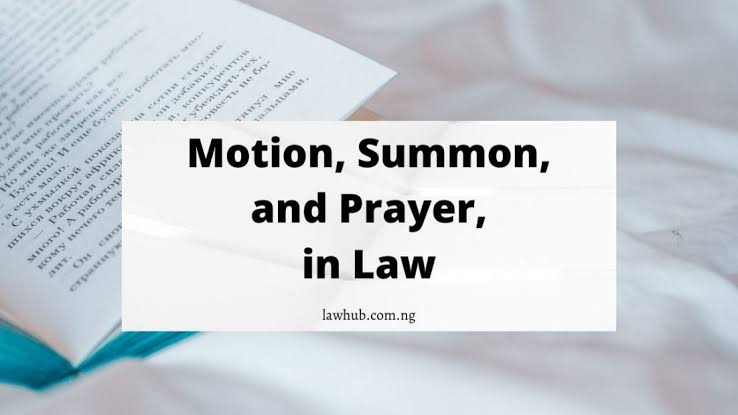Meaning of Motion, Prayer and Summon in Law
Motion, prayer, and summons are common terms in the legal circle. They are of different meanings and distinct usage. This post addresses their basic meaning of motion, prayer, and summon in law.
Meaning of Motion in Law
I once heard a story of a person, an engineer or so, who was in trial without an attorney. And when the judge said, “Move your motion,” he started walking towards the judge, totally oblivious of what the phrase meant.
The meaning of Motion in the legal world is quite different from its meaning in the ordinary sense. Let’s get down to business very quickly.
According to Merriam-Webster Dictionary, a motion is an application made to a court or judge to obtain an order, ruling, or direction. In practice, it is an occasional application to a court by the parties or their counsel.
You know, to obtain some rule, that becomes necessary either in the advancement of a cause, or summarily and wholly disconnected with the entire proceedings.
In other words, a motion is a formal request we make to a judge for an order or judgement. We may make a motion to ask a court to do something, or to avoid doing something.
We may make motions for many reasons in legal practice. Perhaps, to request the postponement of a trial. Or to get the modification of an order. Or to get an application for a temporary child support, among others.
See also: Definitions and Meaning of Law
In most instances, we use a motion to settle an argument over a particular point in the case. So that the rest of the case proceed more effortlessly.
Forms of Motion in Law
Speaking of form, a motion may be in writing, oral, or both. Most motions require a written petition, a written brief, written notice to the attorney for the opposing party and a hearing before the court, chaired by a bench.
For instance, if in a civil case, the complaint is missing crucial information, a defendant may choose to file a motion to dismiss, rather than respond by filling an answer.
We may address examples of motion as follows. Motions of dismiss, discovery motions, summary judgement motions, and vacate default judgement motions.
We make use of a motion when a defendant or respondent asks the court to dismiss all or part to the case, rather than answering it.
With the motion of summary judgement, one side may ask the court to decide a case based on arguments made in court papers. If it is decided that there is no question of fact and the law, then it can be granted.
See also: Positive Theory of Law
We use Discovery motions uniquely to ask a court to make decision on any discovery problem.
Lastly, we use vacate default judgement motions to ask the court to cancel a default judgement.
In all, the use of motions is relatively indispensable in our courts of law.
Meaning of Prayer in Law
In its loose sense, a prayer is a request or petition.
In legal practice, a prayer is that part of the particulars of claim (brief or memorial), when a lawyer asks the court what he wants for his client, as directly as possible.
A prayer can also be seen as a direction of judgement the lawyer wants the court to follow, flowing from the conclusion of his argument.
So, the lawyer that uses a prayer must have already laid the basis for the prayer in the particulars of claim.
As stated above, the prayer must be specific enough to avoid confusion, difficult or even impossible enforcement.
According to Wikipedia, “a prayer of relief, in a law of civil procedure is a portion of a complaint in which the plaintiff describes the remedies that the plaintiff seeks from the court”.
We often find prayers at the end of case briefs or memorials.
For example, we can summarize the prayer for a civil case of Negligence as follows:
“Based on the argument canvased and the judicial authorities cited so far from the pleadings, it can be seen that the pleadings support an award of damages Relying strongly on the foregoing, the plaintiff prays that this court award to the plaintiff an award of damages.”
Legal meaning of Summons
A summon is a legal document, that a court or an administrative agency of government issues, for various purposes.
This term refers to the power of the court to order the presence of anybody, institution, or organization.
In other words, it is the document that officially starts a law suit. In legal parlance, it is a form the law governing procedure prescribes in the court involved.
The court issues it at the time we file a lawsuit. It states the names of litigants (plaintiff and defendant), the title and file number of the case.
We also know a summon as ‘Claim Form’ in England and Wales, and Court Attendance Notice (CAN) in the Australia State of New South Wales.
A summon announces the date in which the person(s) summoned must appear in court. Or respond in writing to the court, or the opposite party or parties (Wikipedia).
See also: Comparison and contrast between Natural and Positive theory of Law
A summon provides a legal note to a party about a lawsuit. It is the first official notice that a defendant receives to notify him or her that he or she or is being sued. It may or may not specify the date for the court proceeding.
Credits:
Wikipedia
Dictionary.law.com
legal-dictionary.thefreedictionary.com


Leave a Reply